Home Food Safety Making the Grade in New York
Making the Grade in New York
Navigating the NYC Restaurant ABC Grading System
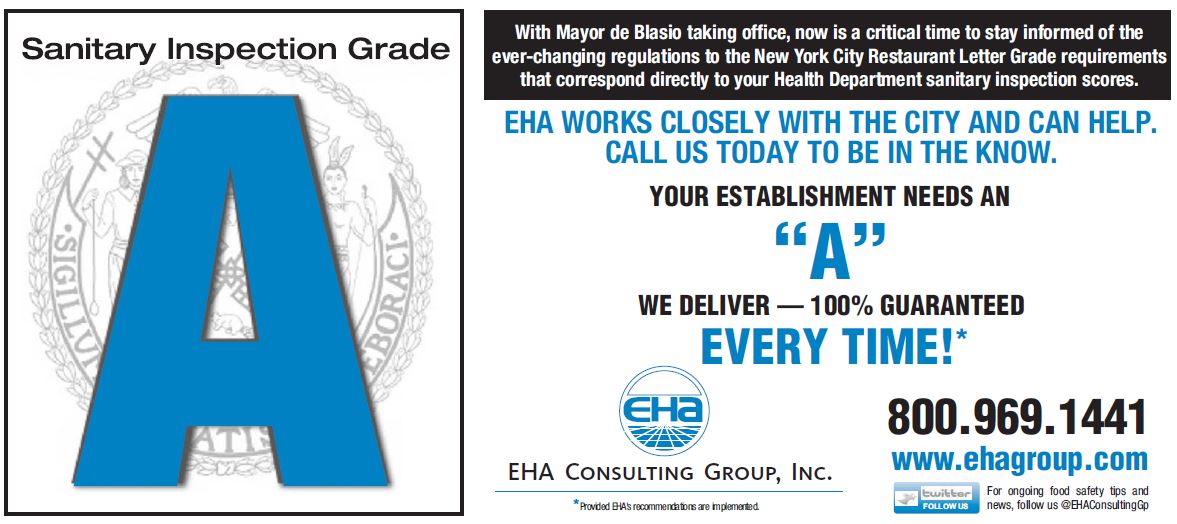
With the adoption of the New York City Department of Health and Mental Hygiene (NYC DOHMH) Grading System and the new scorecard issued for all food facilities in New York City, we at EHA Consulting Group, Inc. feel that this information creates opportunities and important new challenges for us and ultimately you. We endeavor to give you the most accurate and timely information moving your operation into line with these new regulations..
We are pleased to provide you with the latest information from the Department of Health for you to understand the direction from which the City is focusing their attention to the issue of retail food safety and for you to understand how our consultative services can benefit you in complying with these new changes to the regulations. We have condensed the information into a PowerPoint presentation which we are pleased to offer you, along with all of the NYC DOHMH supporting documents
Notably, we have adapted our score sheet for the New York facilities to reflect the NYC DOHMH regulations and will score all inspections accordingly. Please believe that the quality of your inspection is not going to change; only the application of the requirements as expressed in the new score sheet will change. As long as you desire an "A" grade, that is how our program is being aligned.
New Food Safety Requirements
The new requirements specify a series of deficiency points assigned to each violation. The accumulation of 14 deficiency points or more carries the need for a re-inspection no sooner than 7 days, prior to posting the letter grade. The department shall, on the re-inspection, issue a letter grade of "B" to any establishment receiving 14-27 deficiency points and a letter grade of "C" for receiving 28 or more deficiency points. In addition to conducting an initial and any re-inspection for the purpose of establishing a letter grade, the Department may conduct a compliance inspection. The score received on any compliance inspection shall not change an establishment's letter grade for that cycle.
The Department has clarified an inspectional cycle with initial inspection commencing a new cycle. The Department has specified inspection intervals which the Department may or may not strictly adhere to. An initial inspection commencing a new cycle shall be conducted 150 to 210 days after the re-inspection at an establishment that receives a score of 14-27 deficiency points on an initial inspection or re-inspection and does not score 28 deficiency points on either of these inspections. An initial inspection shall be conducted 90-150 days after the final inspection where either the initial or re-inspection receives a score of 28 or more deficiency points.
HACCP Plans Are Essential
One of the requirements places a burden on the operator to write and submit a HACCP plan to the DOHMH for approval if the facility chooses to exceed the requirements of the DOHMH. Furthermore, the approved HACCP plan will then be implemented, along with the required paperwork which is developed and maintained within the facility. Failure to maintain the plan on-site and follow that plan will result in an accumulation of 38 deficiency points and immediately place you into the category of a posted "C".
We are poised to assist you and your operations in the development and submission of a comprehensive HACCP plan and the customization of any documentation associated with the HACCP plan. HACCP plans are generally not a boiler plate exercise but require objective viewpoints and assessments in terms of the type of operation, menu and equipment that you have in your facility.
It is our intention in New York to commence this new inspectional score sheet on or about Monday, August 2, 2010. This score sheet mimics the New York City inspectional protocol for both conditions, severity of conditions and deficiency points required to get the corresponding letter grades. Therefore, on one level, it is a radical departure from our existing score sheet. From another perspective, it truly does not vary that greatly. We will have a passing score equivalent to the City score, particularly when it has critical violations totaling greater than 13 deficiency points, which is the highest deficiency points one can receive in order to be posted with an "A" placard. Clearly, each client can tell us what threshold they desire to trigger a re-inspection.
In trying to get the score sheet harmonized with the New York City document, as well as to make simplistic mathematical sense, we could not have the laboratory component incorporated into the score, which quite frankly some of our clients did not like. Therefore, you will be receiving a separate laboratory score and again, we will be maintaining our policy that any unit that has generic E. coli in a food product would be deemed to need a re-inspection.
In light of the new regulations and inspection system for the City of New York, we have been asked to present information that will prepare the operations in the city for the grading system. However, these adaptations can be used in all the facility throughout the US to strengthen each operation. At EHA we are committed to the highest standard in an inspection program and the education associated with compliance for all the operations that we assist across the country, regardless of jurisdiction.
Letter Grade inspections will begin July 26, 2010
GRADING SYSTEM
- 0-13 Points = "A"
- 14-27 Points = "B"
- 28+ Points = "C"
View EHA Consulting Group's New York HACCP Scoresheet (pdf)
Automatic re-inspections are given if an establishment scores 14 points or higher on their initial inspection – scores will not be posted until you receive a re-inspection (within roughly 14 days).
Three inspections of 28+ points = closing of facilities
This system seems straight forward and it is on the surface. Dig deeper and you realize that as few as two critical violations earns you a B and three takes you to a C. The one thing that you need to consider is the placement of the grade.
The New Letter Grading System Has Not Impacted The Process In Which Sanitary Inspections Will Be Given By The Health Department
The scoring system has changed and some violation scores and condition levels have been changed:
- Appendix 23-A – Inspection Worksheet
- Appendix 23-B – Inspection Scoring Parameters – A Guide to Conditions
It was reported in the New York Post on July 19th that if the system were implemented on time that most of the 6000 inspections conducted in June and July would have resulted in C grades.
- If you receive 14-27 points, on either the initial or re-inspection you will be on a 150-210 day cycle
- If you receive 28 or more on either the initial or re-inspection, you will be on a 90-150 day cycle.
- However a score of 28 or more on the re-inspection will have an additional compliance inspection that will not lead to changing the letter grade or cycle.
What does it take - Critical Violations
-
Food Temperatures
- Improper Cooking is a 10 or 28 point violation only. 10 points if they find it; 28 if it is not Corrected During the Inspection
- Improper Hot Holding 5-8 points based on the number of foods in violation
- Cold holding above 41°F for most foods includes garlic in oil, or above 38°F for ROP foods and smoked fish
- Foods prepared from ambient ingredients below 41°F in 4 hours or less
-
Food Sources
- Dirty or cracked eggs, ranging from 1-25 by groups of 6, points of 7-28
-
Food Protection
- Three compartment sinks will be needed in all facilities
- Closed drink containers are not allowed to contaminate the food stream.
- Wet cloths in sanitizer at the proper concentration and test strips are available
- Presence of vectors and evidence of vectors in varying degrees ranging from 5-28 points
-
Facility Design
- Overhead dust and dirt that could contaminate foods
- Sneeze guards, wrapped portioned products
- Proper thermometers or thermocouples
- Food contact surfaces constructed, located or unacceptable materials
- Food contact surfaces are to be WASHED RINSED and SANITIZED in place after each use
-
Personal Hygiene
- Ill employees will be worth 10 points and failure to remove them will result in 28 points
- All employees working with ready to eat foods are using gloves
- Improper hand washing
Important Considerations:
There is a sliding scale that increases the points associated with the violations, ranging from 5-28 points. Get the inspector in the kitchen as fast as possible and let them do their job!
Examples of Violations:
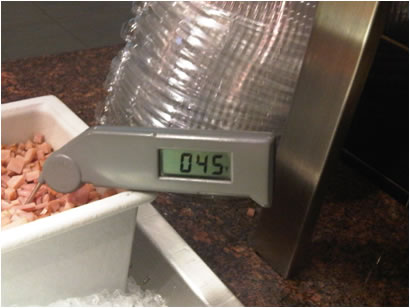
Temperature violation.
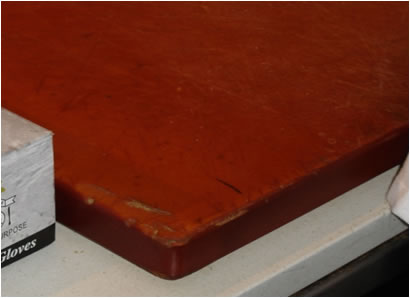
Improperly maintained food contact surface
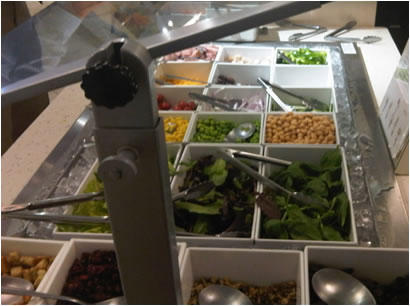
Lack of proper utensils
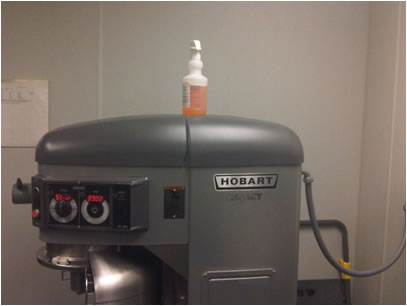
Storage of chemicals
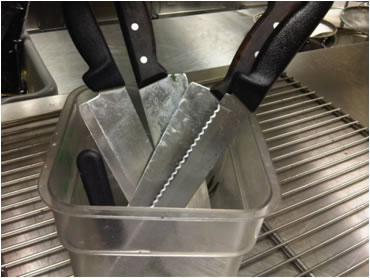
Improper utensil storage
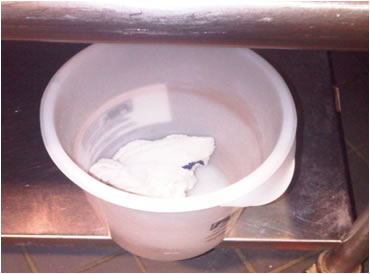
Wiping cloths not in sanitizer
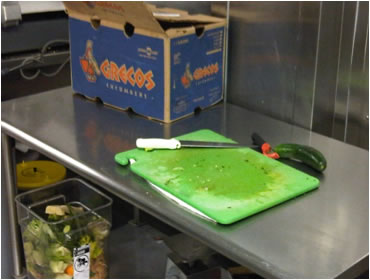
Wiping cloth not returned to sanitizer
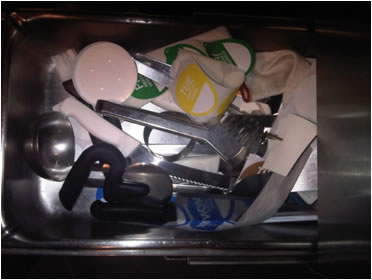
Improper storage of utensils
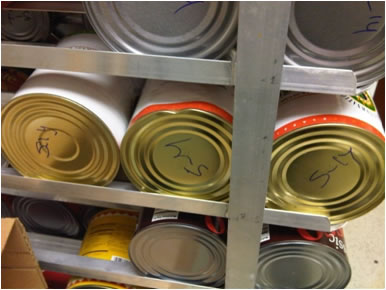
Damaged cans in the product stream
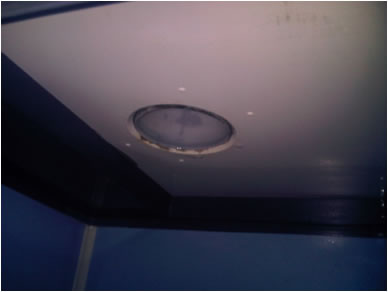
Improper maintenance of non-food contact surfaces
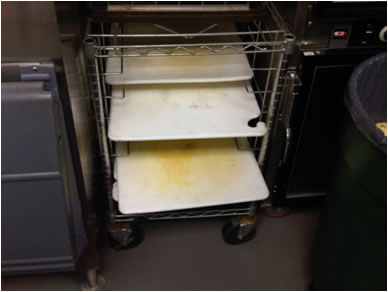
Discolored cutting boards
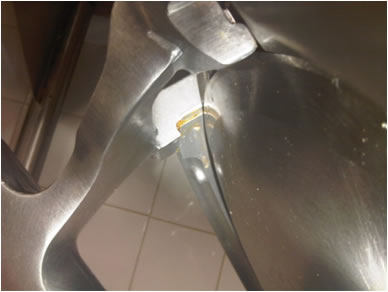
Incomplete cleaning of non-food contact surfaces
General Violations
Points range from 2-5 based on the severity of and/or the number of violations.
- Vermin
- Conditions exist that would attract vermin
- Garbage receptacles will be covered except when in use
- Improper pesticide use
- Open bait stations
- Food Source
- Dented cans will be segregated from other canned goods
- Proper thawing of foods
- Facility Maintenance
- Food contact surfaces damaged, scratched, pitted or discolored
- Toilet facilities maintained with toilet paper, waste receptacle and self-closing door
- Back flow devices, condensate collecting on the floor or into a bucket
- Lighting provided particularly in food production areas, washing areas and storage rooms
- Light guards are in all food handling areas
- Lighting is adequate to inspect the facility
- Other
- Mechanical ventilation operable in toilet rooms, exhaust hoods and no grease collecting on walls
- Thermometers in the hottest part of the refrigeration and the coldest part of hot holders
- Non-food contact surfaces are accessible for cleaning in all sides, sealed, made of porous materials
- Dish machine final rinse will reach 170°F
- Single service utensils and service wares are properly displayed
- Hand washing signs used to identify all hand sinks
New Regulations - Good
Time As A Control For Temperature
Please read our 11/23/10 update on time as a control for temperature in restaurants that offer food for take-out.
- NYC is now recognizing the new FDA code
- Time is now a recognized control in NYC
- Potentially hazardous items (ready to eat/prepared food) may be held out of temperature for up to 4 hours before being discarded as long as the time and temperature are labeled from the beginning
- These potentially hazardous items may be held out of temperature for up to 6 hours if time and temperatures are labeled every 2 hours
- Time must be recorded along with temperature at the start of service
- Foods that are produced from ambient ingredients have 4 hours to get back to 41°F
- Closed drink containers are permitted in the kitchen
- Violations are based on number of items no longer pounds of product
New Regulations - Bad
- NYC DOH has removed most of the Administrative violations from the score sheet
- Fruit Flies are now going to be a critical violation (formerly a general violation)
- Covered garbage containers
- Number of cans that are swollen, leaking or rusted and not segregated from food products
- Food workers can use utensils on ready to eat foods without wearing gloves, WHO DOES and WHO DOESN’T
Be Prepared!
- Completed HACCP plan is submitted to the DOHMH
- Disseminate information to the site management
- Review all the programs for compliance to HACCP
- Review existing documentation for accuracy
- Check that all supplies meet or exceed the plan
- Call your third party auditor
- Find the best place to display your grade
- All HACCP plans need to be reviewed and then submitted to the DOHMH for approval
- Any information that we collect from reviews and even this presentation need to be sent to all management
- All audits need to follow a HACCP compliance format
- Check that you have the correct chemicals, temperatures, recording devices, documents test strips, etc.
- Have all facilities audited by a third party that is focused on HACCP
How EHA Can Help You Achieve and Keep an "A" Grade
-
EHA is prepared to assist you by:
- Writing and submitting your HACCP Program
- Increasing employee training in food safety and NYC DOH compliance
- Increasing re-inspections when unit falls below an “A” grade on an EHA inspection
- We are always available to answers questions and to clarify any concerns arising regarding your NYC DOH Inspections
- Representing your interests before the NYC DOH
We recognize that there will be confusion. We recognize that you will have questions. We recognize that there will be additional need for both re-inspections and consultations, if desired, in reference to individual HACCP plans. Please feel free to contact either of us through our corporate office at (410) 484-9133 with any questions.
Contact EHA Consulting Group today for more information about how we can assist your company.
Please read our blog entry concerning Time as a Control for Temperature in NYC
Diseases, Infections, or Illnesses Acquired
We offer services for
- Retail Food Safety
- Restaurant Food Safety
- Manufacturers
- Food Trucks
- Drugs & Cosmetics
- Melons & Cantaloupes
- Produce
- Warehouses
- Food Packaging & Packaging Materials